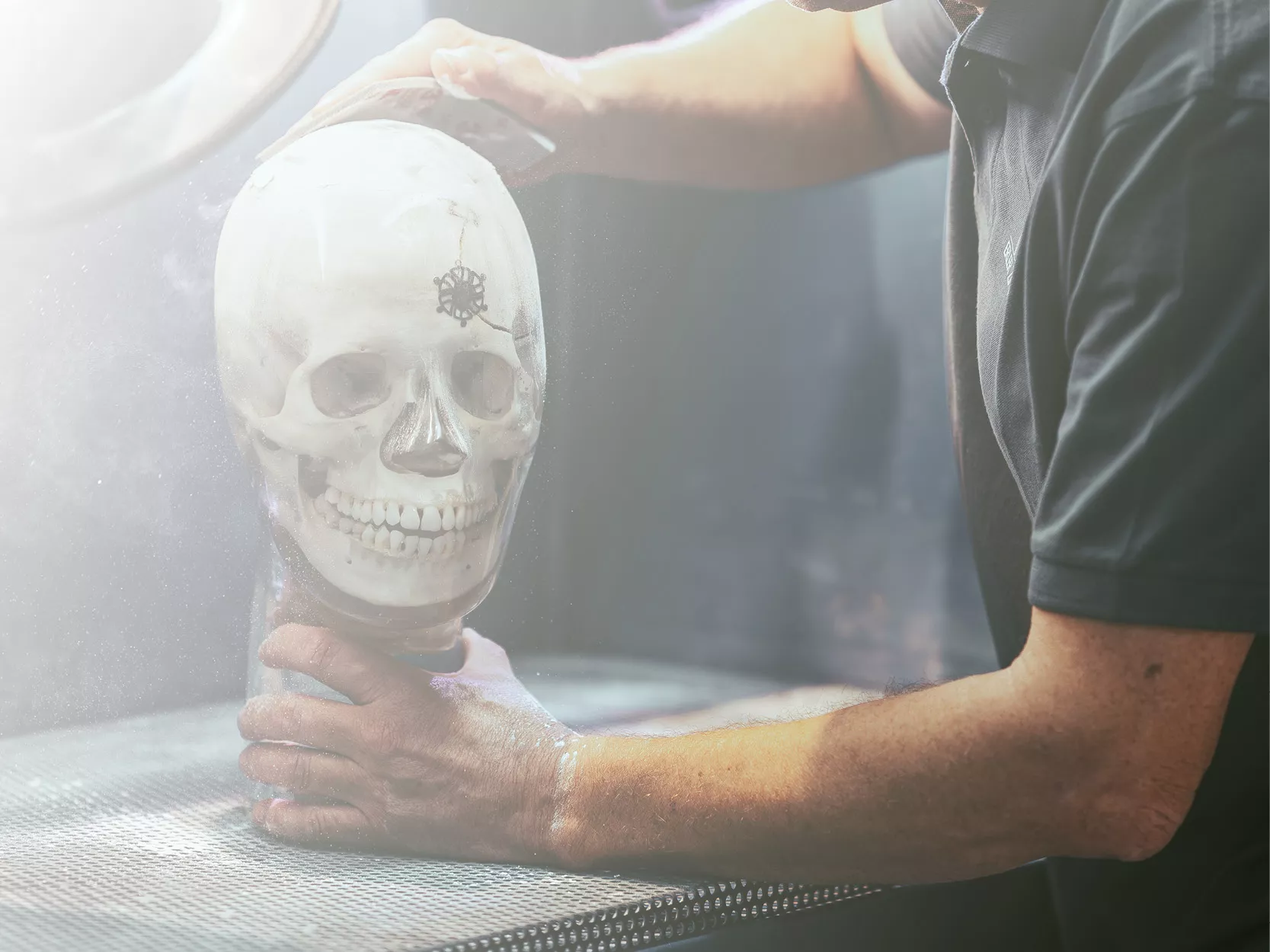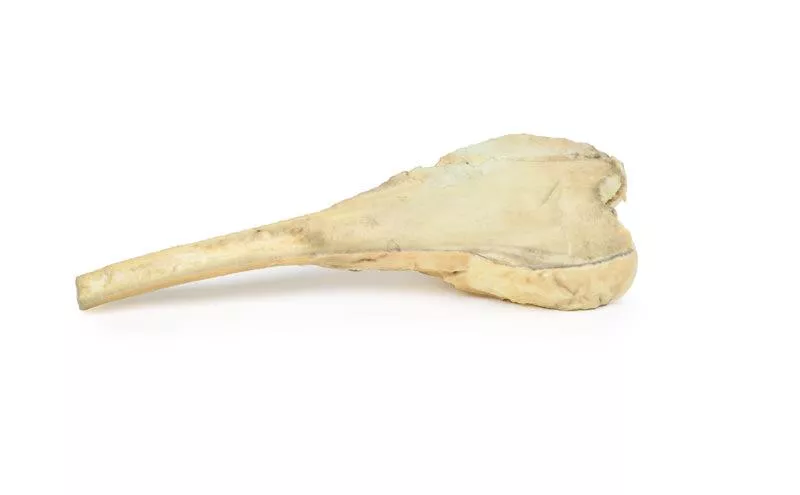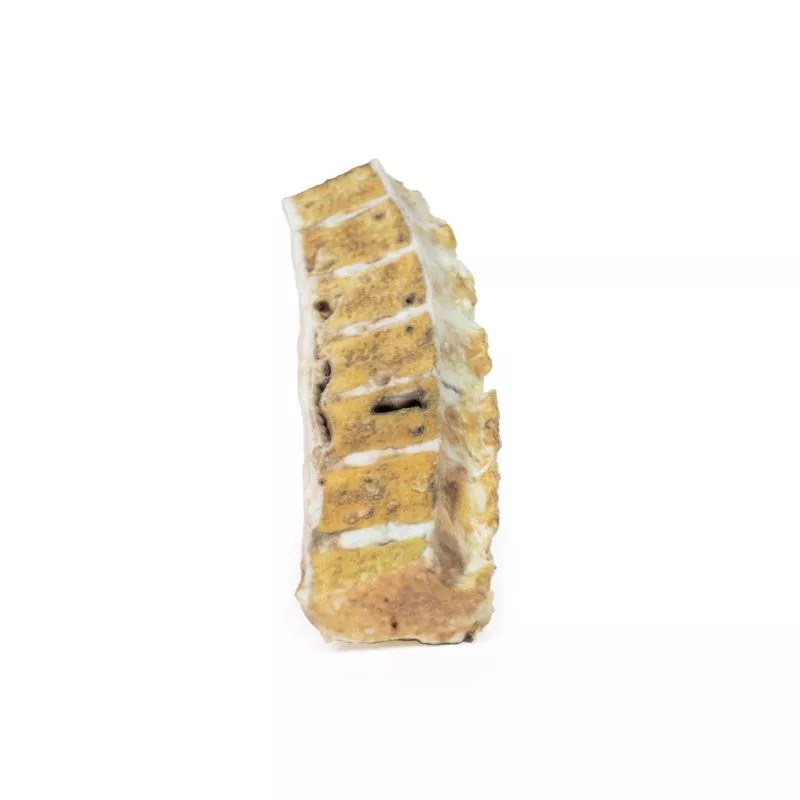Produktinformationen "Osteochondroma"
Klinische Vorgeschichte
Ein 61-jähriger Mann mit Prostatakarzinom stellte sich zur präoperativen Untersuchung vor einer geplanten Prostatektomie vor. Er gab chronische Schmerzen im rechten Knie an, die als Arthrose diagnostiziert worden waren. Zur Abklärung möglicher Knochenmetastasen wurde ein Röntgenbild angefertigt, das eine gestielte Läsion an der medialen Seite des rechten Oberschenkelknochens zeigte. Die Operation verlief planmäßig, jedoch verstarb der Patient später an einer postoperativen Lungenembolie.
Pathologie
Am distalen rechten Femur zeigt sich eine 2?cm lange, gestielte knöcherne Ausziehung 7?cm oberhalb des medialen Kondylus. Die Struktur besteht aus normalem Knochen mit einer hyalinen Knorpelkappe. Es handelt sich um ein typisches Osteochondrom.
Weitere Informationen
Ein Osteochondrom (auch Exostose genannt) ist ein gutartiger knorpeliger Tumor, bestehend aus Knochen mit einer Knorpelkappe. Es ist der häufigste benigne Knochentumor. Die meisten entstehen spontan, manche im Rahmen einer hereditären multiplen Exostosen oder nach Radiotherapie. Sie entstehen meist in der Nähe von Wachstumsfugen, häufig im Kniebereich oder am proximalen Humerus und betreffen häufiger junge Männer.
Die Symptome hängen von Lokalisation und Größe ab. Viele Osteochondrome sind asymptomatisch, können aber durch Nervenkompression, Schmerzen oder Frakturen auffallen. Die Diagnose erfolgt meist durch Röntgen, MRT dient zum Ausschluss einer malignen Entartung. In erblichen Fällen sind EXT1- und EXT2-Mutationen nachweisbar. Nach Epiphysenfugenschluss wächst der Tumor nicht weiter. Eine operative Entfernung ist nur bei Beschwerden notwendig. Die Entartung zum Chondrosarkom ist selten (<1?%), aber in hereditären Fällen erhöht (bis 20?%).
Ein 61-jähriger Mann mit Prostatakarzinom stellte sich zur präoperativen Untersuchung vor einer geplanten Prostatektomie vor. Er gab chronische Schmerzen im rechten Knie an, die als Arthrose diagnostiziert worden waren. Zur Abklärung möglicher Knochenmetastasen wurde ein Röntgenbild angefertigt, das eine gestielte Läsion an der medialen Seite des rechten Oberschenkelknochens zeigte. Die Operation verlief planmäßig, jedoch verstarb der Patient später an einer postoperativen Lungenembolie.
Pathologie
Am distalen rechten Femur zeigt sich eine 2?cm lange, gestielte knöcherne Ausziehung 7?cm oberhalb des medialen Kondylus. Die Struktur besteht aus normalem Knochen mit einer hyalinen Knorpelkappe. Es handelt sich um ein typisches Osteochondrom.
Weitere Informationen
Ein Osteochondrom (auch Exostose genannt) ist ein gutartiger knorpeliger Tumor, bestehend aus Knochen mit einer Knorpelkappe. Es ist der häufigste benigne Knochentumor. Die meisten entstehen spontan, manche im Rahmen einer hereditären multiplen Exostosen oder nach Radiotherapie. Sie entstehen meist in der Nähe von Wachstumsfugen, häufig im Kniebereich oder am proximalen Humerus und betreffen häufiger junge Männer.
Die Symptome hängen von Lokalisation und Größe ab. Viele Osteochondrome sind asymptomatisch, können aber durch Nervenkompression, Schmerzen oder Frakturen auffallen. Die Diagnose erfolgt meist durch Röntgen, MRT dient zum Ausschluss einer malignen Entartung. In erblichen Fällen sind EXT1- und EXT2-Mutationen nachweisbar. Nach Epiphysenfugenschluss wächst der Tumor nicht weiter. Eine operative Entfernung ist nur bei Beschwerden notwendig. Die Entartung zum Chondrosarkom ist selten (<1?%), aber in hereditären Fällen erhöht (bis 20?%).
Erler-Zimmer
Erler-Zimmer GmbH & Co.KG
Hauptstrasse 27
77886 Lauf
Germany
info@erler-zimmer.de
Achtung! Medizinisches Ausbildungsmaterial, kein Spielzeug. Nicht geeignet für Personen unter 14 Jahren.
Attention! Medical training material, not a toy. Not suitable for persons under 14 years of age.







































